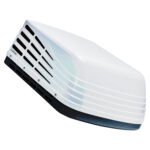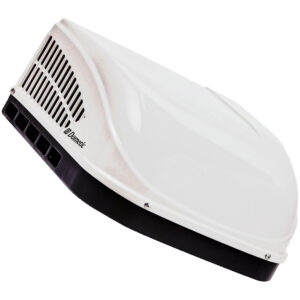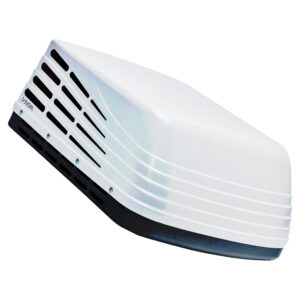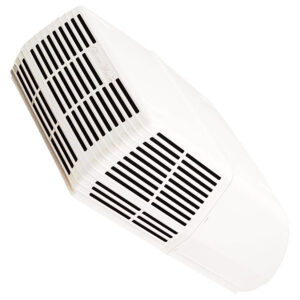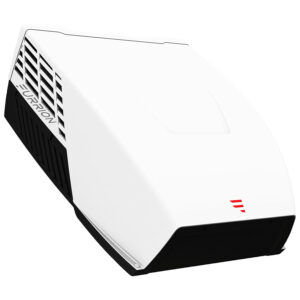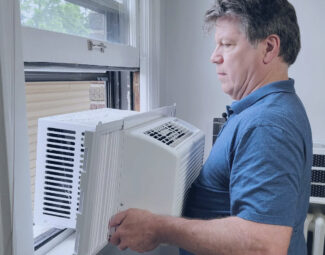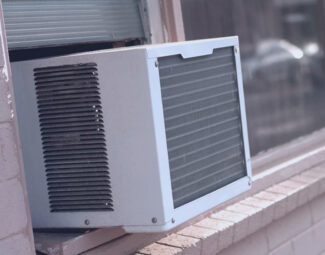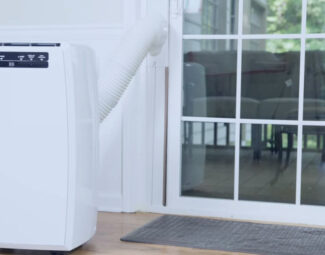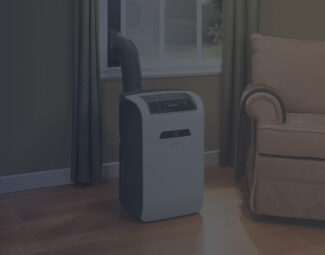1. Dometic Brisk II B59516.XX1C0
Check Price at Amazon
Summary: This is a long-term investment that is worth all the money. Everything, starting with the housing, the motor, the coils, and ending with the small dimensions and lightweight design that makes it easy to mount were carefully thought out to offer the best quality-price report. Apart from that, it is highly versatile and will match any type of RV as it can be both ducted and ductless mounted.
Pros:
- Heavy-duty cooling capacity
- Strong motor and fan
- Easy to install
- Low profile
- Energy-efficient
Preserving the chosen temperature
Produced by one of the most trusted makers in the domain, it is the best unit you can get for your RV at the moment. While most customers pick it for its amazing cooling capacity, we must mention that its construction is very solid as well and up for extensive use. The design is sleek and will look good on any vehicle. Moreover, as it has a low outline, it will produce less air friction and decrease drag, so your engine will consume less fuel on the road.
Efficient Cooling
It uses R41A coolant, which is circulated through its system to absorb the heat from the air. Nevertheless, the strong condenser and evaporator would be useless without a robust fan that can draw the hot air towards the unit and spread the cool air around the enclosed space. Luckily, this model is equipped with everything it needs to produce the best report between performance and costs, which is reflected by the subsequent specifications:
- 15,000 BTUs/hour cooling capacity - is perfect for torrid areas where can provide strong and fast cooling. Similar to the Brisk II is another Dometic product worth checking out if you have a medium or large-size RV, namely the Dometic Penguin II.
- 350 CFM airflow - one of the highest values reached by an RV AC, reduces cooling time and preserves the preferred temperature
- 1,725 watts power intake - makes it compatible with a 2,000W generator
The fan features 3 speeds, which produce different noise levels. The lowest speed is recommended during resting hours, as it is quieter and can run for longer with a lower energy consumption rate. Furthermore, as it comes with a washable return filter, you can rest assured that the air circulated inside will be not only cool but clean.
Easy Installation
It is compact, measuring 29.2 inches in length, 27.2 inches in width, and only 12.7 inches in height, so it is easy to maneuver during fitting. Depending on the AC system and conformation of your vehicle, it may take a while until you get it fixed, but your efforts will be considerably more reduced due to the subsequent features:
- Two installation methods - it offers both ducted and ductless mounting so it is apposite for all types of RVs
- Excellent compatibility - can work both on analog or electric relays and is matching with all 14” x 14” roof gaps
- Lightweight design - at 74 pounds it is easy to lift and manipulate during installation
If you go for the ductless mounting, the good news is that it can pair with variate air distribution boxes so you won’t need to invest in a specific one. Furthermore, it allows you to install a 5,600 BTU heat band, which will provide you with optimal comfort in chilly mornings or nights.
NASA’s Chosen Brand
You are getting a 2-year assurance from a brand that was chosen by NASA to produce an air conditioner for their lunar rover, so there’s no question that it won’t be honored. Apart from that, the fact that this brand was elected the best for NASA’s needs tells us something about the technology and crafting the engineers at Dometic put in their products and the reliability we should expect out of them.
Performance Test Feedback
I have had a camper for about 8 years now, so I was the one who tested this product. Setting it up wasn’t much hassle, just like my old Advent Air AC that this Dometic replaced, the procedure was as straightforward as it gets. A Philips screwdriver and a 3/8” wrench were all the tools we needed for the job. Since I already have the electrical connection kit and ceiling kit in place from my old AC, our work was indeed eased. Moving to what interests you most, performance, I must say I was quite impressed with the Brisk II. It keeps the RV reasonably cool and even managed to preserve a decent temperature when the temperature outside passed the 102 degrees Fahrenheit threshold. The remote is intuitive to use, which is pretty common for all ACs, for that matter. My only complaint would be that the Dometic Brisk II could be a bit quieter. I’ve had other RV air conditioners before and they were more discrete while running.
Lillian Davies – Expert Reviewer and Tester
Dometic Brisk II B59516.XX1C0 Specifications Sheet
|
| Installation Type: Ducted/Non-ducted |
Cooling Capacity: 15,000 BTUs/hour |
Roof Top Unit Dimensions: 29.2” x 27.2” x 12.7” |
| Power Rating: 1,725W |
Airflow: 350 CFM |
Compressor Locked Rotor Amps: 60A |
| Cut-Out Requirements: 14” x 14” |
Base Pan Material: Carbon steel |
Adjustable Fan Speed: |
| Refrigerant Type: R410A |
Refrigerant Charge: N/A |
Weight: 74 pounds |
| Remote Control: |
Electrical Rating: 110V AC, 60 Hz, 1 phase |
Warranty: 2 years |
2. ASA Electronics Advent Air ACM150
Check Price at Amazon
Summary: It provides great operation for a fair price, so if you are interested in the best quality-price report, you have found it. It presents a surprisingly high airflow that can quickly cover a large RV and maintain a comfortable temperature without sounding like an airplane is taking off. Besides that, it is easy to mount, so you will get your vehicle ready for the road in no time.
Pros:
- Great 2-year service contract
- Easy to install and clean
- Superior airflow
- High cooling capacity
- Compatible with multiple AC systems
Cons:
- Loud at high fan speeds
- The outline is rather high and will increase energy consumption
Preserving the chosen temperature
Strongly built and reliable, this model can either substitute an old unit or can be mounted from scratch, as it is versatile and ready to fit almost all preexistent roof gaps. It
works with both ducted and non-ducted arrangements and can be upgraded by attaching accessories that will make it simpler to use. It is
compatible with any Dometic and Advent Air Setup and can function optimally with a Carrier or Coleman Mach setup, but, in this situation, it will require a wire adapter. Moreover, assuming that your van is already pre-wired, the setup is easy, especially as this unit is lighter at
68 pounds, therefore easier to maneuver.
The housing is built of strong plastic that can resist variable weather and offers great protection for the electrical components inside. It is provided with a collapsible gasket and comes with 6 foam pads, aimed to fill the space between the AC and RV roof, thus decreasing the sound and preventing water from pouring inside.
It measures 31-3/16” long, 24-7/8” wide, and 12-13/16” tall. It matches roof holes that have an average surface of 14.25” x 14.25”. If you want a cheaper alternative that fits the same roof hole size, the Dometic Penguin II is your best option. In case the opening is too large, you will need to fill the remaining space with spacers to keep the roof sealed. The installation kit comprises a wiring harness and the necessary hardware for quick mounting.
In terms of functioning, we were pleasantly surprised by its cooling ability, which reaches 15,000 BTUs per hour, a value that is usually attained only by the more pricey models. The superior 6-blade fan generates an excellent 500 CFM airflow, speeding up the cooling process. Moreover, the R410A coolant used by the system (16.9 ounces) is eco-friendly and can be safely used. Once linked to the preexistent thermostat and air distribution box, you will get the chance to alter fan speed and keep an eye on the conditions inside.
At 2,800W, the power intake rate is decent, so a 3,000W generator will be sufficient. The AC draws 15 amperes while functioning, while the compressor uses 12.4 amperes and the fan 2.6 amperes. Besides that, we should mention that it is matching with a multitude of accessories that can increase its convenience. For example, you can attach a start capacitor to jumpstart it in case you can’t get enough power from the generator. Or you can equip it with an electric heat band, which can guarantee a comfortable environment during chilly mornings.
As efficient as it might be, there is one issue with it – the loud, distracting noise it makes when it runs. If this aspect bothers you, look for a quiet window air conditioner instead.
ASA Electronics Advent Air ACM150 Specifications Sheet
|
| Installation Type: Ducted/Non-ducted |
Cooling Capacity: 15,000 BTUs/hour |
Roof Top Unit Dimensions: 31-3/16” x 24-7/8” x 12-13/16” |
| Power Rating: 2,800W |
Airflow: 500 CFM |
Compressor Locked Rotor Amps: 58A |
| Cut-Out Requirements: 14.25” x 14.25” |
Base Pan Material: Metal |
Adjustable Fan Speed: |
| Refrigerant Type: R410A |
Refrigerant Charge: 16.9 oz. |
Weight: 68 pounds |
| Remote Control: |
Electrical Rating: 115V AC |
Warranty: 2 years |
3. Atwood 15027 Ducted
Check Price at Amazon
Summary: If you are planning a trip that implies visiting torrid places, you should reflect on investing in this model. It is not only capable of blasting cool air and maintain a comfortable temperature in a large van but it comes with all you need for convenient use, namely a remote that spares you from getting out of bed to adjust the fan speed, and a wall thermostat for accurate temperature monitoring.
Pros:
- Excellent cooling capacity makes it suitable for hot climates
- Long-lasting construction
- Powerful airflow makes it suitable for large RVs
- Low energy consumption
- Quiet at the lowest speed
- Kit includes a remote control and a wall thermostat
Cons:
- Heavy construction
- Tall profile
Preserving the chosen temperature
If you are going to cross the desert, you will need a unit that can handle extreme heat. This model has a strong motor that uses
16,000 BTUs per hour to replace the hot air inside with polar cool, even if the temperature outside reaches the value of 159F. Although it is one of the strongest available, it maintains a
low power intake of only 1,270 watts, being
matching with a 2,000W generator. Moreover, it preserves a low sound level at the lowest speed, so you can keep it running in the afternoons when you decide to take a nap.
It is conceived for ducted fitting and can fit roof gaps measuring 14” x 14”. The sturdy housing measures 40” in length, 28” in width, and 15” in height, so it is a medium-sized model. It is too thick for us to call it low profile though, so it won’t save you too much fuel during your trips. Nevertheless, the coils are made to last, and the premium fan has excellent capabilities, being able to supply airflow of up to 330 CFM. Moreover, the kit includes multiple accessories that usually need to be acquired separately. For example, it comes with a remote control that allows you to set a timer, select the preferred temperature, or change fan speed from the comfort of your couch.
The best feature, though, is its ability to blow a huge volume of polar air after a long day spent in the burning sun. We mean, how many units can do that? It comes with a wall thermostat that allows you to monitor its effects, and the readout is accurate. Furthermore, although you may struggle a bit to install it, as it weighs 95 pounds, once fixed in position it will serve you for many years to come. Plus, the service contract is attractive, with 2 years being offered for parts and labor.
If you want a portable solution to keep the temperature at a reasonable level in the RV even during summer, the dual hose portable air conditioner is the best alternative for you.
Atwood 15027 Ducted Specifications Sheet
|
| Installation Type: Ducted |
Cooling Capacity: 16,000 BTUs/hour |
Roof Top Unit Dimensions: 40” x 28” x 15” |
| Power Rating: 1,270W |
Airflow: 330 CFM |
Compressor Locked Rotor Amps: 63A |
| Cut-Out Requirements: 14” x 14” |
Base Pan Material: N/A |
Adjustable Fan Speed: |
| Refrigerant Type: R410A |
Refrigerant Charge: 24 oz. |
Weight: 95 pounds |
| Remote Control: |
Electrical Rating: 115V, 60 Hz |
Warranty: 2 years |
4. Coleman Mach 3 Plus
Check Price at Amazon
Summary: With its strongly-built fan motor, evaporator, and housing, this air cooler is everything you need for years of comfortable vacations. It offers 13,500 BTUs of chilling per hour and has a huge airflow capacity, so it will start and run perfectly even if you are driving through the desert. Moreover, if you acquire the heat band, you will be able to create great comfort during chilly mornings and keep your family happy and ready for a new adventure.
Pros:
- Sturdy construction can stand severe weather
- The motor can start in extreme heat conditions
- High airflow makes it apposite for large RVs
- Energy-efficient
- Low outline design
Cons:
- Compatible only with Coleman pre-installed systems
- It gets a bit too noisy when it runs
Preserving the chosen temperature
Provided with a hefty evaporator and quality coils with elevated lance fins, it can easily take out the heat in a wide range of RVs, including towable models and motorhomes. It is a popular pick among buyers, who pick it for its low outline, intended to reduce drag during driving and, thus, decreases energy consumption. Compared with other models, it is smaller, with a length of 38 inches, a width of 26.1 inches, and as thick as 13.8 inches, and weighs only 79.5 pounds. Nevertheless, we should mention that it is not compatible with other AC constructions, so you will need to acquire both the rooftop and the ceiling modules, which are sold individually.
The high-airflow fan offers two speed options and can deliver up to 320 CFM, which is a very competitive value. The cooling reaches 13,500 BTUs per hour and the unit uses environment-friendly R410A refrigerant to reduce heat and deliver fresh air across the entire vehicle. The motor is rated for 15.3 amperes for the cooling action and can draw 16 amperes if you decide to add the optional 5,600 BTUs heat strip. This attachment will prove useful on chilly days when you need a bit of warmth to get comfortable. Regarding power consumption, it draws around 1,400 watts in normal conditions, but the rate can go as high as 1,695 watts if you run it in desert settings or even higher, reaching 1,800 watts with the heat strip. Nonetheless, it is compatible with a 2,000W generator, and, compared with other models, we would even call it cost-efficient.
It fits any 14” x 14” rooftop cut, and the mounting process isn’t very difficult, although you will need to mount both the rooftop and the ceiling parts. For enhanced control over the functions and accurate temperature monitoring, you will want to acquire the control package and wall thermostat offered by the maker. This being said, once you get everything installed, you will be able to experience its notable cooling capabilities and make use of the 2-year service contract in case any mishap shall occur.
Coleman Mach 3 Plus Specifications Sheet
|
| Installation Type: Ducted/Non-ducted |
Cooling Capacity: 13,500 BTUs/hour |
Roof Top Unit Dimensions: 38” x 26.1” x 13.8” |
| Power Rating: 1,400W |
Airflow: 320 CFM |
Compressor Locked Rotor Amps: 50.5A |
| Cut-Out Requirements: 14” x 14” |
Base Pan Material: N/A |
Adjustable Fan Speed: |
| Refrigerant Type: R410A |
Refrigerant Charge: N/A |
Weight: 79.5 pounds |
| Remote Control: |
Electrical Rating: 115V, 60 Hz |
Warranty: 2 years |
5. RecPro 15K Ducted
Summary: If you need a ducted unit, consider this RecPro model since the 15,000 BTUs per hour guarantee that powerful cooling is one of the product’s strong points. Upkeep is not much hassle since the screen filter is easy to remove. Furthermore, since it was designed to withstand harsh operating conditions, there’s no need to worry that you might encounter issues regardless of the camping sport you choose.
Pros:
- Included remote control for convenient operation
- Screen filter can be easily removed for routine cleaning
- Suited for spaces up to 875 square feet in size
- Designed to withstand harsh conditions
- Produces only 59.1 dB on the high fan setting
Cons:
- It’s very heavy
- Blows the cold air at a lower volume compared to other ACs
Preserving the chosen temperature
The cooling and heating abilities of the RecPro make it one of the best options for year-round camping.
It is rated at 15,000 BTUs per hour cooling capacity, so needless to say, you won’t have to suffer through heat waves anymore. Just set the AC at the temperature you prefer and in a matter of minutes, you will feel the ambiance in your motorized home turning pleasant. It uses an R410A refrigerant, so you can see where its efficiency stems from.
This is a ducted model, so if you are looking for non-ducted installation, you should opt for the ASA Electronics Advent Air ACM150 or the Dometic Brisk II B59516.XX1C0 instead. It is recommended for spaces of up to 875 square feet, so if you have a spacious camper, it will surely handle bringing the temperature down in it without any hassle.
Operating noise is generally a big concern with air conditioners of all sorts, with RV units more than others since these specific systems tend to be quite loud. However, the RecPro is an exception since it produces only 59.1 decibels on the highest running speed. So, if you are camping with your family or friends, chances are that you won’t even hear it run while you’re carrying conversations.
Beware that when you install this AC you will definitely need a helping hand since the unit weighs 80 pounds. It’s among the heaviest models, so maneuvering it alone is out of the question. Speaking of installation, keep in mind that it’s designed for flat roofs or roofs that don’t have a higher inclination than 5 degrees. The thickness of the roof must also range from 3” to 5-5/16” in thickness. With the package, you receive a remote for convenient control. When it comes to backing, it’s provided for 2 years after you make the purchase.
RecPro 15K Ducted Specifications Sheet
|
| Installation Type: Ducted |
Cooling Capacity: 15,000 BTUs/hour |
Roof Top Unit Dimensions: 13-11/16” x 26-3/4” x 39-5/16” |
| Power Rating: N/A |
Airflow: 351 CFM |
Compressor Locked Rotor Amps: N/A |
| Cut-Out Requirements: 14” x 14” |
Base Pan Material: Steel |
Adjustable Fan Speed: |
| Refrigerant Type: R410A |
Refrigerant Charge: 23 oz. |
Weight: 80.3 pounds |
| Remote Control: |
Electrical Rating: 115V |
Warranty: 2 years |
6. Furrion FACR15SA-PS
Summary: The Furrion is one of the standout camper air conditioners for its design and efficiency. The 15,500 BTU cooling power unit is aerodynamically designed and features dual-fan technology, which makes it the superior option when compared to most roof ACs available today. Best of all, the asking price is quite reasonable opposed to units in its cooling capacity range, which is another undeniable plus.
Pros:
- Moves the air faster and more efficiently since it features dual motors
- The cover is UV resistant and it features thermal insulation
- Vibrations are reduced by the rubber dampeners on the compressor
- High EER score of 2.19
- Backed against defects for 2 years
Cons:
- Makes a lot of noise when it runs
- Poor installation instructions
Preserving the chosen temperature
In terms of cooling power, the only model that surpasses this 15,500 BTUs/hour Furrion is the Atwood 15027 Ducted that is rated at 16,000 BTUs per hour. Therefore, if you’re looking for a bit more ‘juice’, that’s your only viable alternative. It’s suited for either ducted or non-ducted installation, so regardless of the setup that you need, it complies with your demands.
It features overload protection to ensure a lasting operation. With an energy efficiency score of 2.19, it is one of the most cost-effective solutions to keep the RV cool even during the most torrid summer days when the camper starts to feel like an oven. It flaunts an aerodynamic design and features 2-way airflow, which adds to its efficiency. There are 3 speed options to pick from, so you can customize its operation how you prefer at any given point.
It is fitted with a start capacitor that gives an extra boost when you start the AC even when the generator isn’t providing sufficient power. An interesting design element stands in the rubber dampeners on the compressor that serve the purpose of reducing vibrations. Speaking of design, the cover is UV resistant and features thermal insulation to keep the internal parts safe and prevent motor overheating.
It’s not the quietest option you will stumble upon, the 80 dB outdoor sound pressure level making it quite distracting. Since it weighs 81.6 pounds, don’t try to install it on your own because you won’t be able to properly maneuver this behemoth and it might end up dropping out of your hands. So, keep in mind from the get-go that this is a 2-person job. To end on a high note, we mention that backing is standard – like all the other ACs we tested and reviewed, the Furrion FACR15SA-PS is covered against defects for 2 years.
Furrion FACR15SA-PS Specifications Sheet
|
| Installation Type: Ducted/Non-ducted |
Cooling Capacity: 15,500 BTUs/hour |
Roof Top Unit Dimensions: 27.56” x 13.62” x 34.81” |
| Power Rating: 1,720W |
Airflow: N/A |
Compressor Locked Rotor Amps: N/A |
| Cut-Out Requirements: 14” x 14” |
Base Pan Material: Steel |
Adjustable Fan Speed: |
| Refrigerant Type: R410A |
Refrigerant Charge: 23.1 oz. |
Weight: 81.6 pounds |
| Remote Control: |
Electrical Rating: 115V, 60 Hz |
Warranty: 2 years |
7. Airxcel 08-0080 Mach 15
Check Price at Amazon
Summary: Effectiveness is the key here, and this unit’s outstanding potential guarantees that you will never have to spend a day sweating in your vehicle. Vacations are about comfort and relaxation, so even if it is a serious investment, it’s worth the financial effort. Furthermore, it is apposite for ducted fitting, so if you chose this variant, you won’t need to spend extra cash on the ceiling unit.
Pros:
- Durable construction makes it suitable for intense use
- High airflow and BTU capacity ensure great cooling in extreme heat conditions
- Eco-friendly
- Fan speed can be adjusted
- Generous 2-year warranty
Cons:
- Rather heavy and difficult to maneuver
- High profile increases the power intake
Preserving the chosen temperature
This model is almost a classic, as it has already been tested by many customers who further recommended it for its strong structure. According to their comments, it was able to remain intact even after horrible delivery conditions. The remarkable quality of the housing is easy to observe, and there’s no doubt that it can handle rain, sun, dust, and debris. The
motor is super strong as well at 1/3 HP. It is, in fact, the biggest motor used for an RV AC, so you shouldn’t be surprised when you discover its excellent capabilities.
It produces 15,000 BTUs per hour and can produce an airflow of 320 CFM, so there’s no doubt that it will maintain a comfortable environment even if you are traveling through the desert. The only options more powerful than the Airxcel when it comes to cooling capacity are the Furrion FACR15SA-PS and the Atwood 15027 Ducted, so look into one of these units if you consider that 15,000 BTUs isn’t enough for your camper. The typical consumption rate stays around 1,560 watts, with a peak of 1,800 watts that is reached if you decide to install the optional 5,600 BTUs heat strip. The compressed locked rotor amps reach a value of 61. The R410A coolant is carefully sealed inside the system and won’t get dissipated into the air. Plus, it is eco-friendly. Nevertheless, it’s good to know that you have the possibility of a non-ducted fitting. You just need to acquire the corresponding ceiling unit.
The copper tubes and gas-flux brazed joints make it resistant to wear and guarantee a longer lifespan. However, we have remarked that it is rather heavy at 90 pounds, therefore it can be difficult to lift and maneuver it while mounting it. Moreover, it isn’t the most compact, with a length of 42 inches and a width of 28 inches. Not to mention that the 16 inches profile is high and will increase the mileage on your generator. But despite its heavy construction, customers continue to pick it, and this proves that its operation and toughness make for these drawbacks, especially as the 2-year service contract is promptly honored.
Airxcel 08-0080 Mach 15 Specifications Sheet
|
| Installation Type: Ducted |
Cooling Capacity: 15,000 BTUs/hour |
Roof Top Unit Dimensions: 42” x 28” x 16” |
| Power Rating: 1,560W |
Airflow: 320 CFM |
Compressor Locked Rotor Amps: 61A |
| Cut-Out Requirements: 14” x 14” |
Base Pan Material: Plastic |
Adjustable Fan Speed: |
| Refrigerant Type: R410A |
Refrigerant Charge: N/A |
Weight: 90 pounds |
| Remote Control: |
Electrical Rating: 115V, 60 Hz |
Warranty: 2 years |
Alternative RV Air Conditioners Worth Checking Out
Aside from the products that we listed in our top, there are a few other models that we deem almost as effective and worthy of your attention. While these ACs didn’t make it into our top, you shouldn’t disconsider these options since their performance is on par with the highest demands. We decided against including them simply because they come from the same manufacturer as some of our picks, and the models we chose to list in our top instead fared slightly better in some departments. Here are the alternative products we recommend you look into if you don’t find a fitting option among the products we reviewed before or if you simply want to do a thorough comparison before you decide:
#1. Dometic H541816AXX1C0 Blizzard NXT
A
15,000 BTUs model that prides itself with the durable build typical for all Dometic products. The Blizzard NXT boasts an
aerodynamic design that helps its performance and makes it easy on the eye. Inside ceiling installation is possible with this product, but you do have to separately purchase the kit for it. It provides constant, reliable performance thanks to the high-capacity output fan it features, as well as the
motor with 350 CFM blower. It’s easy to install and works for ducted or non-ducted application. Additionally, it features
foam insulation that is intelligently placed to minimize heat transfer and maintain the air it produces cool.
Why we chose to leave it out: It has the same BTU rating as the Dometic Brisk II B59516.XX1C0, so performance-wise, both products fare the same. We chose to include the Brisk II in our top and leave the Blizzard NXT model as an alternative simply because the Brisk II seemed a bit quieter. However, the difference was almost unnoticeable, so you should pick depending on which product you prefer and have the necessary budget for.
#2. Dometic Penguin II
This Dometic product is rated at
13,500 BTUs cooling power. For maximum cooling efficiency, it uses the
eco-friendly R410A refrigerant. In terms of design, this is one of the most durably-built products thanks to the
rib-reinforced base pan it comes with. Nevertheless, the durable build is fairly typical for Dometic products, so it comes as no surprise that the Penguin II also boasts it. Another design element that makes this product worthwhile is the
EPP foam it features that not only increases its cooling efficiency, but also reduces its weight. This, in turn, makes your job easier when installing it.
Why we chose to leave it out: It has a slightly lower BTU output than the Dometic Brisk II B59516.XX1C0, which makes it suited for medium-sized RVs instead of large ones. This doesn’t shed a negative light on the Penguin II, it just makes the AC better for different demands in terms of cooling performance. Choose between the two depending on the BTU rating you need for your RV.
#3. Coleman 48204C866 Mach 15+
An year-round AC that you can count on to get you through harsh winters and torrid summers. The Mach 15+ is rated at
15,000 BTUs cooling, and also provides
5,600 BTUs of heat if you opt for the extra heating assembly available for it. And it does all this for a little over $1,000 in terms of upfront costs. The
1/3 HP fan motor it is fitted with delivers
320 cubic feet per minute of cool air, so you know that the temperature inside the RV is quickly regulated by this product. The Mach 15+ excels when it comes to design too thanks to the
streamlined shape it flaunts that helps enhance airflow and cooling efficiency.
Why we chose to leave it out: It is a bit more powerful than the Coleman Mach 3 Plus in terms of cooling, but we decided to only mention it as an alternative because we already had enough 15,000 BTU ACs in our top. Pick the Mach 15+ if you need this higher BTU rating for your camper and you want to enjoy the Coleman quality guarantee.
Frequently Asked Questions
Are RV air conditioners efficient?
Whether ducted or non-ducted, RV AC units do indeed make a difference when it comes to the ambiance in your motorized home, bringing temperatures down when the heatwave strikes. However, the non-ducted ACs are less efficient since they only blow cold air from the ceiling. This makes non-ducted models better suited for smaller rigs.
How long do camper air conditioners last?
The estimated lifespan of an RV AC is 3 to 5 years. However, the exact lifespan depends on how well you treat the AC when it comes to performing routine maintenance and servicing it when the time comes, and how often you use the cooling system altogether.
Why does the RV AC leak when it rains?
If this issue arises only when it rains outside, it shows that a bad seal or rubber gasket where the AC meets the RV roof is at fault. So, you just have to check all seals and gaskets to find the problem.
How can I keep the RV AC from freezing?
While this can occur when the temperatures are extremely low, if the AC has been properly serviced and maintained, it shouldn’t happen. Generally, however, the culprits for this issue are airflow obstructions, dirty coils, dirty filters, or a faulty thermostat.
How often should I check the AC refrigerant levels?
If the AC is a sealed system type, you won’t ever have to check refrigerant levels. In case you are suspecting a leak or the AC stops cooling properly, what you should do is call in a qualified professional to check the air conditioner and perform the needed repairs.
Why does the AC trip breakers when it’s turned on?
This issue generally appears when the voltage is too low, too many appliances are running simultaneously, or there are obstructions.
When should I clean the AC’s air filter?
This depends on frequency of use. If you frequently keep it on, then it’s recommended to clean the air filter at least two times per year. However, we advise that you check the included user manual to see if the manufacturer recommendations differ from your specific RV AC model.
What is the best RV air conditioner brand?
Coleman and Dometic are widely regarded as the best RV AC manufacturers due to the efficiency, quality, and durability of their products. There are other notable brands that we recommend you buy from since their air conditioners are just as qualitative, namely ASA Electronics, Airxcel, Atwood, RecPro, and Furrion.
Conclusion
In the end, when picking the AC unit for your RV, it all comes down to 3 essential questions. Is it sufficiently strong to cool the whole surface? Can it function in high heat? Does it have a sturdy construction that can last through the years? If all of these criteria have been matched, then it is time to think about your finances and taste.
We took care of the first part of this inquiry. Now it’s time for you to decide which of the models from above will look best on your motorhome. A quick second glance at the best models in this selection may help you decide.
Best RV Air Conditioner for Sale: Dometic Brisk II B59516.XX1C0
With superior construction and outstanding cooling capacity, it is a favorite among buyers. It is packed in and easy to mount due to its light design and wide compatibility. The low height will help you save fuel by decreasing the RV’s drag, while the energy-effective fan won’t put too much strain on your generator. Apart from that, it delivers an excellent airflow that makes it apposite for large vans.
Editor’s Choice: ASA Electronics Advent Air ACM150
You can count on it to quickly cool your camper or RV since it is rated at 15,000 BTUs. What adds to its efficiency is the 6-blade fan that guarantees sufficient airflow, namely 500 cubic feet per minute. While with other RV ACs you might worry that gaps between the air conditioner and the roof might cause issues when it comes to proper cooling, this issue won’t ever appear with the ACM150 since it features a collapsible gasket and 6 foam pads.
Best RV Air Conditioner for Extreme Heat: Atwood 15027 Ducted
It can work in temperatures as high as 159F and will manage to release a blast of cool air even if it has sat the entire day in the sun. The 16,000 BTUs per hour cooling rate cannot be matched by any of the units on this top and even on the market. Furthermore, the wall thermostat and remote are comprised in the price, making it a very convenient deal.
Best RV Air Conditioner for the Money: Furrion FACR15SA-PS
With a high cooling capacity of 15,500 BTUs per hour and fairly priced considering its overall capabilities, the Furrion is the best camper AC money can buy. It even boasts an EER score of 2.19 that indicates the unit won’t draw as much power as its competitors do to provide the same pleasant living conditions. On top of this, it’s designed with safety and durability in mind, which is why it features overload protection. So, you are making a lasting acquisition if you opt for it.

